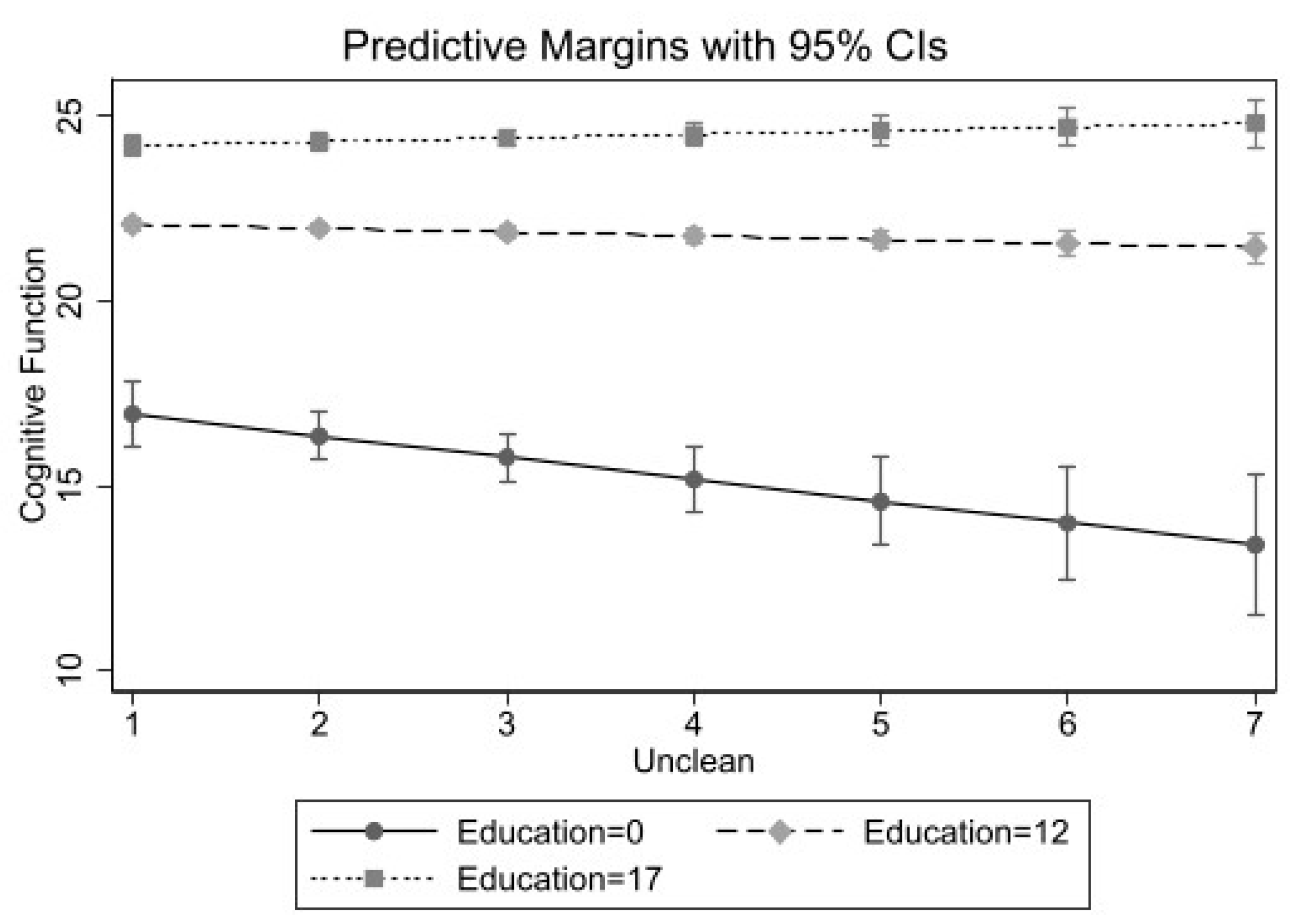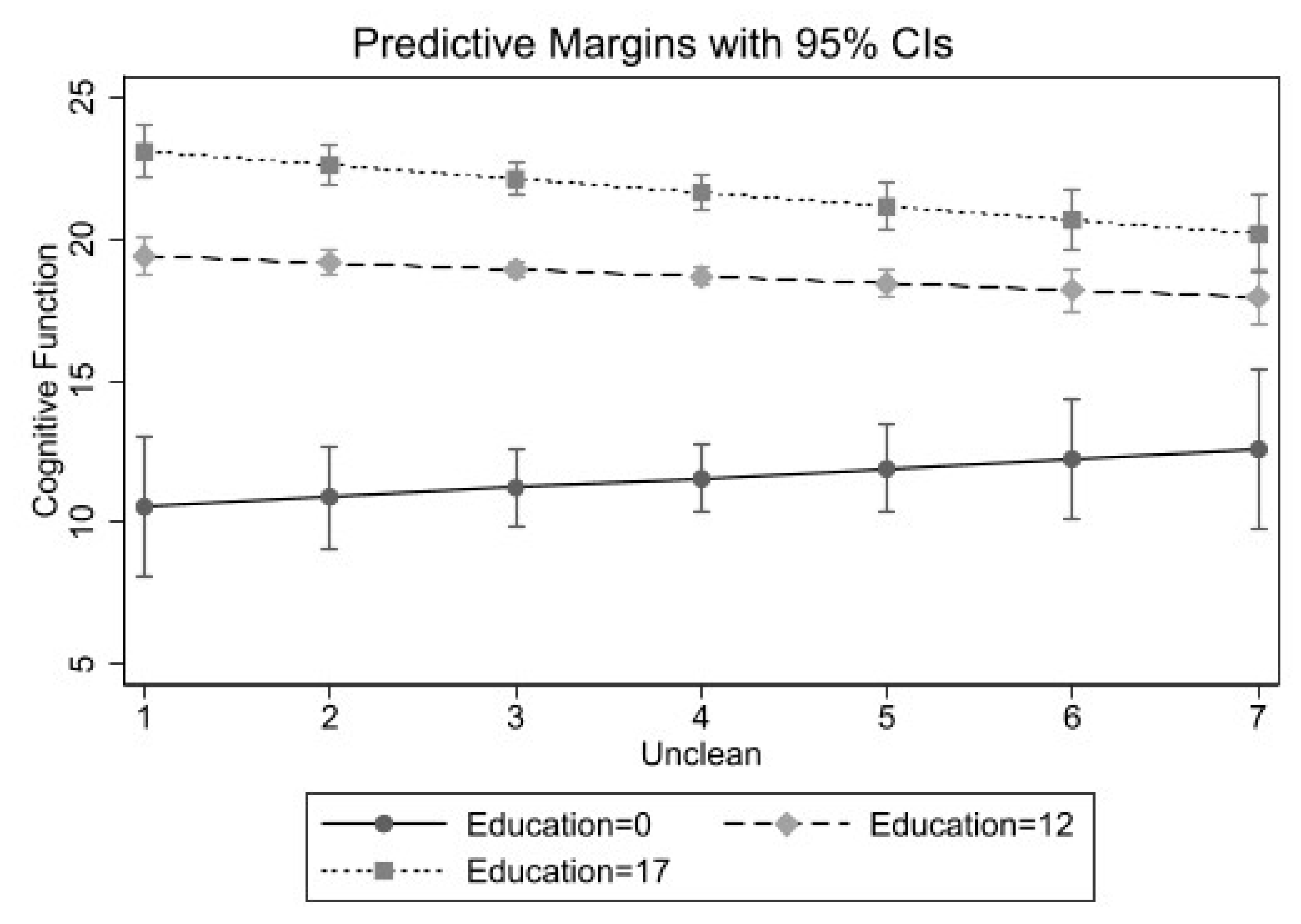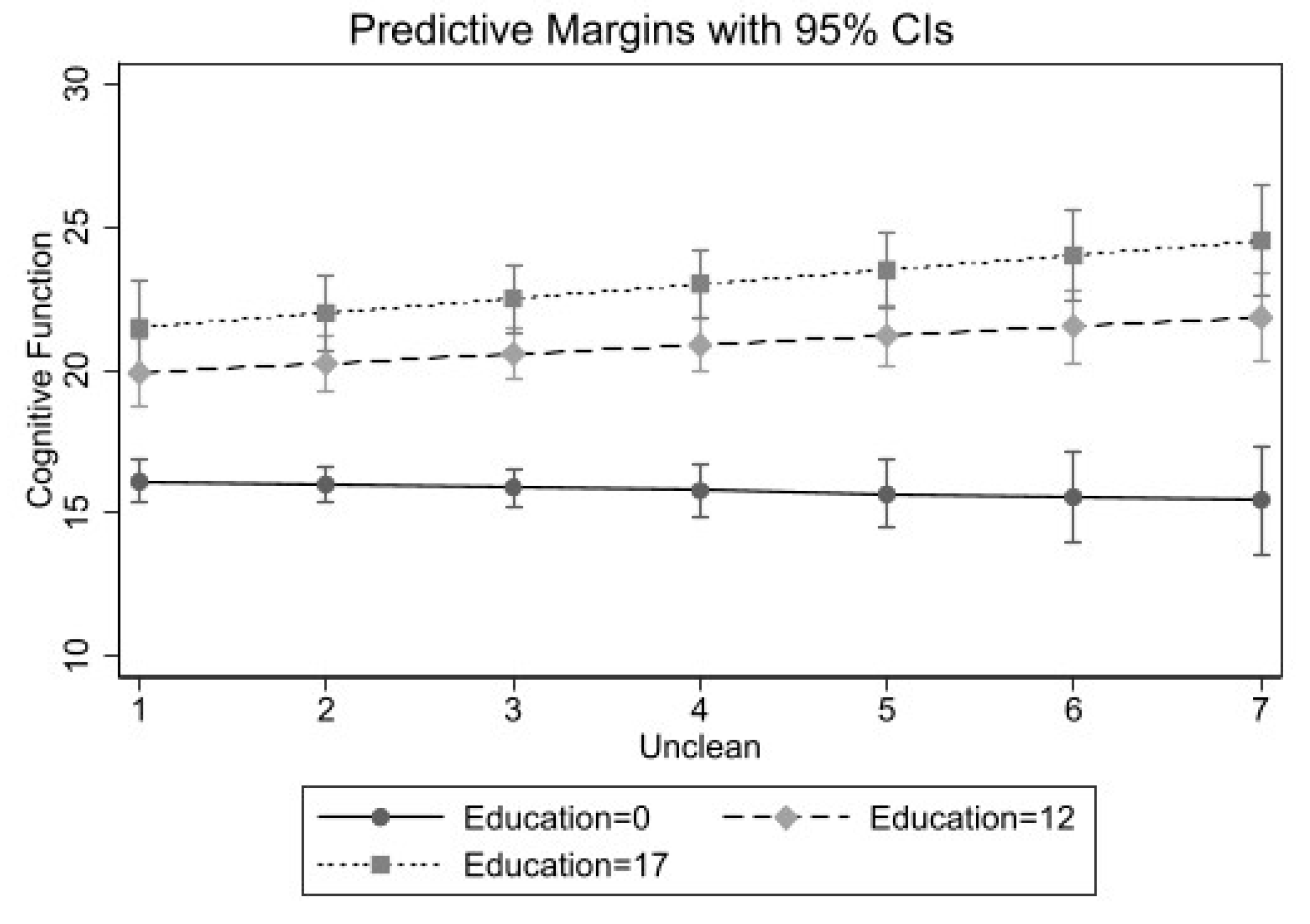Perceived Neighborhood Characteristics and Cognitive Functioning among Diverse Older Adults: An Intersectional Approach
Abstract
1. Introduction
1.1. Disparities in Cognitive Function
1.2. Neighborhoods and Cognition
1.3. Intersectionality
- (1)
- Are perceived neighborhood characteristics associated with cognitive functioning among older US adults?
- (2)
- Is the association between perceived neighborhood characteristics and cognitive functioning moderated by race/ethnicity, gender, and education?
2. Materials and Methods
2.1. Sample
2.2. Measures
2.2.1. Cognitive Functioning
2.2.2. Neighborhood Perceptions
2.2.3. Demographic Characteristics
2.2.4. Health Characteristics
2.3. Analytic Strategy
3. Results
3.1. Descriptive Statistics
3.2. Regression Analyses
4. Discussion
5. Conclusions
Supplementary Materials
Author Contributions
Funding
Institutional Review Board Statement
Informed Consent Statement
Data Availability Statement
Conflicts of Interest
References
- Mujahid, M.S.; Diez Roux, A.V.; Cooper, R.C.; Shea, S.; Williams, D.R. Neighborhood Stressors and Race/Ethnic Differences in Hypertension Prevalence (the Multi-Ethnic Study of Atherosclerosis). Am. J. Hypertens. 2011, 24, 187–193. [Google Scholar] [CrossRef] [PubMed]
- Barber, S.; Hickson, D.A.; Wang, X.; Sims, M.; Nelson, C.; Diez-Roux, A.V. Neighborhood Disadvantage, Poor Social Conditions, and Cardiovascular Disease Incidence among African American Adults in the Jackson Heart Study. Am. J. Public Health 2016, 106, 2219–2226. [Google Scholar] [CrossRef] [PubMed]
- Robinette, J.W.; Charles, S.T.; Gruenewald, T.L. Neighborhood Cohesion, Neighborhood Disorder, and Cardiometabolic Risk. J. Soc. Sci. Med. 2018, 198, 70–76. [Google Scholar] [CrossRef]
- Diez Roux, A.V.; Mair, C. Neighborhoods and Health. Ann. N. Y. Acad. Sci. 2010, 1186, 125–145. [Google Scholar] [CrossRef]
- Williams, D.R.; Collins, C. Racial Residential Segregation: A Fundamental Cause of Racial Disparities in Health. Public Health Rep. 2001, 116, 404–416. [Google Scholar] [CrossRef]
- Barnes, L.L.; Bennett, D.A. Alzheimer’s Disease in African Americans: Risk Factors and Challenges for the Future. Health Aff. 2014, 33, 580–586. [Google Scholar] [CrossRef]
- Forrester, S.N.; Gallo, J.J.; Whitfield, K.E.; Jr, R.J.T. A Framework of Minority Stress: From Physiological Manifestations to Cognitive Outcomes. Gerontologist 2019, 59, 1017–1023. [Google Scholar] [CrossRef]
- Meyer, O.L.; Mungas, D.; King, J.; Hinton, L.; Farias, S.; Reed, B.; DeCarli, C.; Geraghty, E.; Beckett, L. Neighborhood Socioeconomic Status and Cognitive Trajectories in a Diverse Longitudinal Cohort. Clin. Gerontol. 2018, 41, 82–93. [Google Scholar] [CrossRef]
- Thierry, A.D. Association between Telomere Length and Neighborhood Characteristics by Race and Region in US Midlife and Older Adults. Health Place 2019. [Google Scholar] [CrossRef]
- Whitfield, G.P.; Carlson, S.A.; Ussery, E.N.; Watson, K.B.; Brown, D.R.; Berrigan, D.; Fulton, J.E. Racial and Ethnic Differences in Perceived Safety Barriers to Walking, United States National Health Interview Survey—2015. Prev. Med. 2018, 114, 57–63. [Google Scholar] [CrossRef]
- Stokes, J.E. Trajectories of Perceived Neighborhood Quality across the Life Course: Sociodemographic Determinants and Implications for Well-Being. Soc. Sci. Res. 2019, 79, 181–193. [Google Scholar] [CrossRef] [PubMed]
- Weuve, J.; Barnes, L.L.; de Leon, C.F.M.; Rajan, K.B.; Beck, T.; Aggarwal, N.T.; Hebert, L.E.; Bennett, D.A.; Wilson, R.S.; Evans, D.A. Cognitive Aging in Black and White Americans: Cognition, Cognitive Decline, and Incidence of Alzheimer Disease Dementia. Epidemiology 2018, 29, 151–159. [Google Scholar] [CrossRef] [PubMed]
- Alzheimer’s Association. 2020 Alzheimer’s Disease Facts and Figures. Alzheimer’s Dement. 2020, 16, 391–460. [Google Scholar] [CrossRef]
- Babulal, G.M.; Quiroz, Y.T.; Albensi, B.C.; Arenaza-Urquijo, E.; Astell, A.J.; Babiloni, C.; Bahar-Fuchs, A.; Bell, J.; Bowman, G.L.; Brickman, A.M.; et al. Perspectives on Ethnic and Racial Disparities in Alzheimer’s Disease and Related Dementias: Update and Areas of Immediate Need. Alzheimer’s Dement. 2019, 15, 292–312. [Google Scholar] [CrossRef]
- Diaz-Venegas, C.; Downer, B.; Langa, K.M.; Wong, R. Cognitive Functioning of U.S. Adults by Race and Hispanic Origin. In Contextualizing Health and Aging in the Americas: Effects of Space, Time and Place; Vega, W.A., Angel, J.L., Robledo, L.M.F.G., Markides, K.S., Eds.; Springer: Berlin/Heidelberg, Germany, 2019; pp. 1–383. [Google Scholar] [CrossRef]
- Glymour, M.M.; Manly, J.J. Lifecourse Social Conditions and Racial and Ethnic Patterns of Cognitive Aging. Neuropsychol. Rev. 2008, 18, 223–254. [Google Scholar] [CrossRef] [PubMed]
- Yen, I.H.; Michael, Y.L.; Perdue, L. Neighborhood Environment in Studies of Health of Older Adults: A Systematic Review. Am. J. Prev. Med. 2009, 37, 455–463. [Google Scholar] [CrossRef] [PubMed]
- Besser, L.M.; McDonald, N.; Song, Y.; Kukull, W.A.; Rodriguez, D.A. Neighborhood Environment and Cognition in Older Adults: A Systematic Review. Am. J. Prev. Med. 2017, 53, 241–251. [Google Scholar] [CrossRef] [PubMed]
- Aneshensel, C.S.; Ko, M.J.; Chodosh, J.; Wight, R.G. The Urban Neighborhood and Cognitive Functioning in Late Middle Age. J. Health Soc. Behav. 2011, 52, 163–179. [Google Scholar] [CrossRef] [PubMed]
- Basta, N.E.; Matthews, F.E.; Chatfield, M.D.; Brayne, C. Community-Level Socio-Economic Status and Cognitive and Functional Impairment in the Older Population. Eur. J. Public Health 2008, 18, 48–54. [Google Scholar] [CrossRef]
- Clarke, P.J.; Ailshire, J.A.; House, J.S.; Morenoff, J.D.; King, K.; Melendez, R.; Langa, K.M. Cognitive Function in the Community Setting: The Neighborhood as a Source of ‘cognitive Reserve’? J. Epidemiol. Community Health 2012, 66, 730–736. [Google Scholar] [CrossRef] [PubMed]
- Lee, B.K.; Glass, T.A.; James, B.D.; Bandeen-Roche, K.; Schwartz, B.S. Neighborhood Psychosocial Environment, Apolipoprotein E Genotype, and Cognitive Function in Older Adults. Arch. Gen. Psychiatry 2011, 68, 314–321. [Google Scholar] [CrossRef]
- Sharifian, N.; Spivey, B.N.; Zaheed, A.B.; Zahodne, L.B. Psychological Distress Links Perceived Neighborhood Characteristics to Longitudinal Trajectories of Cognitive Health in Older Adulthood. Soc. Sci. Med. 2020, 258. [Google Scholar] [CrossRef] [PubMed]
- Schulz, A.; Northridge, M.E. Social Determinants of Health: Implications for Environmental Health Promotion. Heal. Educ. Behav. 2004, 31, 455–471. [Google Scholar] [CrossRef] [PubMed]
- Vespa, J.; Medina, L.; Armstrong, D. Demographic Turning Points for the United States: Population Projections for 2020 to 2060. Curr. Popul. Rep. 2020, P25, 1144. [Google Scholar]
- Brown, T.H.; Richardson, L.J.; Hargrove, T.W.; Thomas, C.S. Using Multiple-Hierarchy Stratification and Life Course Approaches to Understand Health Inequalities. J. Health Soc. Behav. 2016, 57, 200–222. [Google Scholar] [CrossRef]
- Garcia, M.A.; Downer, B.; Chiu, C.-T.; Saenz, J.L.; Rote, S.; Wong, R. Racial/Ethnic and Nativity Differences in Cognitive Life Expectancies among Older Adults in the United States. Gerontologist 2019, 59, 281–289. [Google Scholar] [CrossRef] [PubMed]
- Haan, M.N.; Zeki Al-Hazzouri, A.; Aiello, A.E. Life-Span Socioeconomic Trajectory, Nativity, and Cognitive Aging in Mexican Americans: The Sacramento Area Latino Study on Aging. J. Gerontol. Ser. B Psychol. Sci. Soc. Sci. 2011, 66B (Suppl. 1), 102–110. [Google Scholar] [CrossRef]
- Wight, R.G.; Aneshensel, C.S.; Miller-Martinez, D.; Botticello, A.L.; Cummings, J.R.; Karlamangla, A.S.; Seeman, T.E. Urban Neighborhood Context, Educational Attainment, and Cognitive Function among Older Adults. Am. J. Epidemiol. 2006, 163, 1071–1078. [Google Scholar] [CrossRef]
- Brown, T.H. Racial Stratification, Immigration, and Health Inequality: A Life Course-Intersectional Approach. Soc. Forces 2018, 96, 1507–1540. [Google Scholar] [CrossRef]
- Bauer, G.R. Incorporating Intersectionality Theory into Population Health Research Methodology: Challenges and the Potential to Advance Health Equity. Soc. Sci. Med. 2014, 110, 10–17. [Google Scholar] [CrossRef]
- Bowleg, L. The Problem with the Phrase Women and Minorities: Intersectionality-an Important Theoretical Framework for Public Health. Am. J. Public Health 2012, 102, 1267–1273. [Google Scholar] [CrossRef] [PubMed]
- Viruell-Fuentes, E.A.; Miranda, P.Y.; Abdulrahim, S. More than Culture: Structural Racism, Intersectionality Theory, and Immigrant Health. Soc. Sci. Med. 2012, 75, 2099–2106. [Google Scholar] [CrossRef]
- Williams, D.R.; Sternthal, M. Understanding Racial-Ethnic Disparities in Health: Sociological Contributions. J. Health Soc. Behav. 2010, 51 (Suppl. 1), S15–S27. [Google Scholar] [CrossRef]
- Crenshaw, K.W. Mapping the Margins: Intersectionality, Identity Politics, and Violence against Women of Color. Stanf. Law Rev. 1991, 43, 1241–1299. [Google Scholar] [CrossRef]
- Crimmins, E.M.; Kim, J.K.; Langa, K.M.; Weir, D.R. Assessment of Cognition Using Surveys and Neuropsychological Assessment: The Health and Retirement Study and the Aging, Demographics, and Memory Study. J. Gerontol. B Psychol. Sci. Soc. Sci. 2011, 66 (Suppl. 1), 162–171. [Google Scholar] [CrossRef]
- Blankson, A.N.; McArdle, J.J. A Brief Report on the Factor Structure of the Cognitive Measures in the HRS/AHEAD Studies. J. Aging Res. 2014, 2014. [Google Scholar] [CrossRef] [PubMed]
- Wallace, R.B.; Herzog, A.R.; Ofstedal, M.B.; Steffick, D.; Fonda, S.; Langa, K. Documentation of Affective Functioning Measures in the Health and Retirement Study; Survey Research Center, University of Michigan: Ann Arbor, MI, USA, 2000. [Google Scholar]
- Assari, S.; Lankarani, M.M. Race and Urbanity Alter the Protective Effect of Education but Not Income on Mortality. Front. Public Health 2016, 4, 1–9. [Google Scholar] [CrossRef] [PubMed]
- Boen, C. The Role of Socioeconomic Factors in Black-White Health Inequities across the Life Course: Point-in-Time Measures, Long-Term Exposures, and Differential Health Returns. Soc. Sci. Med. 2016, 170, 63–76. [Google Scholar] [CrossRef]
- Farmer, M.M.; Ferraro, K.F. Are Racial Disparities in Health Conditional on Socioeconomic Status? Soc. Sci. Med. 2005, 60, 191–204. [Google Scholar] [CrossRef] [PubMed]
- Farmer, H.R.; Wray, L.A.; Haas, S.A. Race, Gender, and Socioeconomic Variations in C-Reactive Protein Using the Health and Retirement Study. J. Gerontol. Ser. B Psychol. Sci. Soc. Sci. 2020. [Google Scholar] [CrossRef] [PubMed]
- Sherman-Wilkins, K.J.; Thierry, A.D. Education as the Great Equalizer? Racial and Ethnic Differences in the Effect of Education on Cognitive Impairment in Later Life. Geriatrics 2019, 4. [Google Scholar] [CrossRef]
- Zahodne, L.B.; Manly, J.J.; Smith, J.; Seeman, T.; Lachman, M. Socioeconomic, Health, and Psychosocial Mediators of Racial Disparities in Cognition in Early, Middle, and Late Adulthood. Psychol. Aging 2017, 32, 118–130. [Google Scholar] [CrossRef] [PubMed]
- Thomas, C.S. A New Look at the Black Middle Class: Research Trends and Challenges. Sociol. Focus 2015, 48, 191–207. [Google Scholar] [CrossRef]
- Williams, D.R.; Mohammed, S.A.; Leavell, J.; Collins, C. Race, Socioeconomic Status, and Health: Complexities, Ongoing Challenges, and Research Opportunities. Ann. N. Y. Acad. Sci. 2010, 1186, 69–101. [Google Scholar] [CrossRef]
- Mandalaywala, T.M.; Petrullo, L.A.; Parker, K.J.; Maestripieri, D.; Higham, J.P. Vigilance for Threat Accounts for Inter-Individual Variation in Physiological Responses to Adversity in Rhesus Macaques: A Cognition × Environment Approach. Dev. Psychobiol. 2017, 59, 1031–1038. [Google Scholar] [CrossRef]
- Tucker, A.M.; Stern, Y. Cognitive Reserve in Aging. Curr. Alzheimer Res 2011, 8, 354–360. [Google Scholar] [CrossRef]
- Stern, Y. What Is Cognitive Reserve? Theory and Research Application of the Reserve Concept. J. Int. Neuropsychol. Soc. 2002, 8, 448–460. [Google Scholar] [CrossRef]
- Avila, J.F.; Rentería, M.A.; Jones, R.N.; Vonk, J.M.J.; Turney, I.; Sol, K.; Seblova, D.; Arias, F.; Hill-Jarrett, T.; Levy, S.A.; et al. Education Differentially Contributes to Cognitive Reserve across Racial/Ethnic Groups. Alzheimer’s Dement. 2021, 17, 70–80. [Google Scholar] [CrossRef] [PubMed]



| Overall (n = 8023) | White (n = 6616) | Black (n = 1044) | Mexican (n = 363) | |
|---|---|---|---|---|
| Cognitive functioning | 22.12 (0.11) | 22.54 (0.11) | 18.85 (0.19) * | 19.20 (0.37) * |
| Neighborhood Characteristics | ||||
| (Un)safety | 2.44 (0.03) | 2.35 (0.03) | 3.27 (0.06) * | 2.96 (0.12) * |
| (Un)cleanliness | 2.32 (0.03) | 2.23 (0.02) | 3.09 (0.06) * | 2.84 (0.14) * |
| (Dis)cohesion | 2.38 (0.02) | 2.31 (0.02) | 3.03 (0.05) * | 2.78 (0.10) * |
| Sociodemographic Characteristics | ||||
| Age | 74.18 (0.16) | 74.34 (0.18) | 73.22 (0.33) * | 72.28 (0.37) * |
| Foreign-born | 5.48% | 4.22% | 4.99% | 38.42% * |
| Woman | 56.00% | 55.52% | 59.97% * | 59.21% |
| Education (years) | 13.00 (0.07) | 13.28 (0.06) | 11.92 (0.12) * | 8.66 (0.37) * |
| Income ($ thousands) | 62.74 (2.16) | 66.32 (2.36) | 37.04 (1.58) * | 31.64 (1.63) * |
| Wealth ($ thousands) | 574.42 (29.80) | 627.15 (31.83) | 162.96 (9.16) * | 192.29 (19.14) * |
| Married/partnered | 61.32% | 63.05% | 40.69% * | 65.33% |
| Behavioral Risk Factors | ||||
| Smoking status | ||||
| Never smoker | 42.57% | 42.63% | 41.03% | 44.55% |
| Former smoker | 48.74% | 49.10% | 46.60% | 44.47% |
| Current smoker | 8.69% | 8.27% | 12.37% * | 10.97% |
| Alcohol use | ||||
| No consumption | 63.73% | 62.00% | 77.39% * | 75.70% * |
| Moderate consumption | 30.70% | 32.51% | 17.46% * | 15.59% * |
| Heavy consumption | 5.57% | 5.48% | 5.15% | 8.71% |
| Moderate/vigorous physical activity | ||||
| Never | 22.09% | 21.49% | 28.71% * | 22.07% |
| Sometimes | 25.44% | 24.79% | 30.08% * | 31.34% * |
| Frequent | 52.46% | 53.72% | 41.21% * | 46.58% * |
| Health Characteristics | ||||
| Obese | 30.80% | 29.69% | 41.31% * | 34.53% |
| Number of chronic conditions | 2.29 (0.02) | 2.27 (0.02) | 2.56 (0.05) * | 2.26 (0.07) |
| CES-D ≥ 3 | 17.24% | 16.55% | 20.36% * | 27.35% * |
| Unsafe | Unclean | Social Discohesion | |
|---|---|---|---|
| Variable | b (SE) | b (SE) | b (SE) |
| Neighborhood Characteristic | −0.51 * (0.20) | −0.58 ** (0.20) | −0.95 ** (0.27) |
| Woman | 1.43 *** (0.18) | 1.33 *** (0.22) | 1.11 *** (0.20) |
| Education | 0.40 *** (0.04) | 0.39 *** (0.04) | 0.33 *** (0.05) |
| Woman x Neighborhood | |||
| Characteristic | −0.06 (0.06) | −0.02 (0.08) | 0.07 (0.07) |
| Education x Neighborhood | |||
| Characteristic | 0.03 * (0.01) | 0.04 ** (0.01) | 0.06 ** (0.02) |
| Constant | 25.5 *** (1.07) | 25.6 *** (1.03) | 26.5 *** (1.28) |
| R2 | 0.31 | 0.31 | 0.31 |
| F (22, 6593) | 128.43 *** | 127.36 *** | 128.17 *** |
| Unsafe | Unclean | Social Discohesion | |
|---|---|---|---|
| Variable | b (SE) | b (SE) | b (SE) |
| Neighborhood Characteristic | 0.48 (0.38) | 0.36 (0.38) | 0.57 (0.42) |
| Woman | 0.18 (0.69) | 0.80 (0.64) | 0.99 (0.71) |
| Education | 0.82 *** (0.11) | 0.79 *** (0.11) | 0.82 *** (0.12) |
| Woman x Neighborhood | |||
| Characteristic | 0.14 (0.18) | −0.05 (0.16) | −0.13 (0.20) |
| Education x Neighborhood | |||
| Characteristic | −0.05 † (0.01) | −0.05 † (0.03) | −0.06 † (0.03) |
| Constant | 15.2 *** (1.07) | 15.6 *** (3.25) | 14.7 *** (3.32) |
| R2 | 0.37 | 0.37 | 0.37 |
| F (22, 1021) | 24.67 *** | 24.51 *** | 24.47 *** |
| Unsafe | Unclean | Social Discohesion | |
|---|---|---|---|
| Variable | b (SE) | b (SE) | b (SE) |
| Neighborhood Characteristic | 0.36 * (0.13) | −0.07 (0.28) | 0.22 (0.22) |
| Woman | 0.001 (0.20) | −0.18 (0.97) | 0.20 (0.84) |
| Education | 0.40 *** (0.04) | 0.28 *** (0.06) | 0.34 *** (0.05) |
| Gender x Neighborhood | |||
| Characteristic | −0.06 (0.06) | −0.07 (0.31) | −0.19 (0.26) |
| Education x Neighborhood | |||
| Characteristic | −0.01 (0.02) | 0.04 * (0.01) | 0.01(0.02) |
| Constant | 31.0 (3.40) | 32.2 *** (3.50) | 31.5 *** (3.41) |
| R2 | 0.40 | 0.40 | 0.40 |
| F (22, 340) | 8.08 *** | 8.00 *** | 8.02 *** |
Publisher’s Note: MDPI stays neutral with regard to jurisdictional claims in published maps and institutional affiliations. |
© 2021 by the authors. Licensee MDPI, Basel, Switzerland. This article is an open access article distributed under the terms and conditions of the Creative Commons Attribution (CC BY) license (http://creativecommons.org/licenses/by/4.0/).
Share and Cite
Thierry, A.D.; Sherman-Wilkins, K.; Armendariz, M.; Sullivan, A.; Farmer, H.R. Perceived Neighborhood Characteristics and Cognitive Functioning among Diverse Older Adults: An Intersectional Approach. Int. J. Environ. Res. Public Health 2021, 18, 2661. https://doi.org/10.3390/ijerph18052661
Thierry AD, Sherman-Wilkins K, Armendariz M, Sullivan A, Farmer HR. Perceived Neighborhood Characteristics and Cognitive Functioning among Diverse Older Adults: An Intersectional Approach. International Journal of Environmental Research and Public Health. 2021; 18(5):2661. https://doi.org/10.3390/ijerph18052661
Chicago/Turabian StyleThierry, Amy D., Kyler Sherman-Wilkins, Marina Armendariz, Allison Sullivan, and Heather R. Farmer. 2021. "Perceived Neighborhood Characteristics and Cognitive Functioning among Diverse Older Adults: An Intersectional Approach" International Journal of Environmental Research and Public Health 18, no. 5: 2661. https://doi.org/10.3390/ijerph18052661
APA StyleThierry, A. D., Sherman-Wilkins, K., Armendariz, M., Sullivan, A., & Farmer, H. R. (2021). Perceived Neighborhood Characteristics and Cognitive Functioning among Diverse Older Adults: An Intersectional Approach. International Journal of Environmental Research and Public Health, 18(5), 2661. https://doi.org/10.3390/ijerph18052661






